The Best Authentic Italian Sunday Gravy (Sugo)
This authentic recipe for Italian Sunday gravy (sauce) - or sugo, as my family calls it - is a rich tradition that's been passed down through my Sicilian family for generations. It's a homemade red sauce that gets simmered for hours with meatballs, Italian sausage, and melt-in-your-mouth pieces of tender slow cooked pork. Traditionally served on Sundays, this iconic Italian recipe is perfect for big family gatherings, special occasions or any night of the week.
This post may contain affiliate links.

The smell of sauce simmering on the stove always brings me back to Sundays at my grandparent's house growing up, when the whole family would gather around for what we call "pasta sugo." Those memories hold a really special place in my heart.
I come from a big Sicilian American family, and gathering on Sundays to eat pasta with red sauce and slowly cooked meats has always been a tradition in our family. My great grandparents came to America as Italian immigrants and brought their Sunday ritual for making "pasta sugo" along with them.
Here in New Jersey, there's an age-old debate about whether this dish is called "sauce" or "gravy." Where I live, and every Italian American makes their pasta sauce a different way, and they all have strong opinions about what it's called.
In our family, we never really called it sauce or gravy ("gravy is for turkey," my pop-pop would say). Our family calls it sugo, which is the Italian word for sauce. No matter what you call it - sugo, sauce or gravy - this is a recipe you definitely want to make.
This recipe for authentic Italian red gravy is ideal for feeding a large group. We serve it at every single family gathering - Christmas, Easter, and sometimes even Thanksgiving - along with other Italian specialties like sausage and peppers, chicken Milanese, eggplant parmesan and lasagna.
While red gravy does require several hours of low and slow cooking, the actual hands-on prep is pretty minimal. This is the best Sunday gravy recipe because it's incredibly forgiving and adaptable. It can easily be scaled up or down to accommodate your number of guests.
But best of all, it freezes beautifully. I always make a full batch even if it's just Chaser and I eating dinner. Then I freeze the leftovers for quick and easy dinners to enjoy another day.
Everyone makes their sauce a little bit different. What makes this recipe special is that ultimately you get to decide what tastes best, and continue the tradition on in your own way.
I'm so excited to share my version of my Sicilian family's authentic recipe for Sunday Sugo, aka pasta sugo, aka Sunday gravy, Sunday sauce, red gravy, or whatever you want to call it. The important thing is that you make it and share it with the people you love.
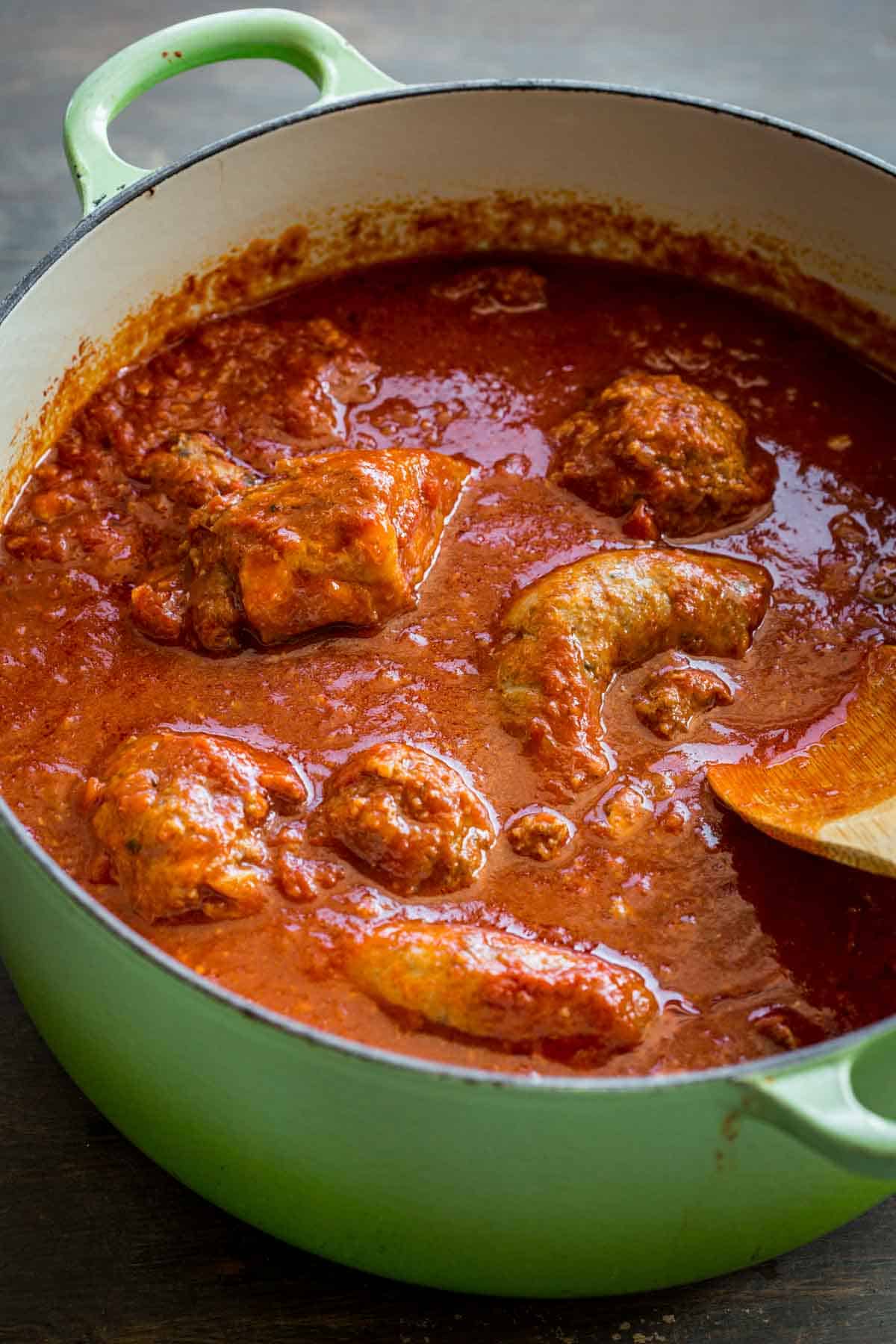
Why this recipe works
- An authentic recipe, made with quality ingredients, passed down from my Sicilian family.
- Cooked low and slow to coax out rich depth of flavor and make ultra tender, melt-in-your-mouth meat, but with minimal hands-on prep.
- Incredibly versatile and adaptable. Adjust the ingredients and quantities to suit your needs and make it how YOU like it.
- Serves a crowd and is great for parties and special occasions.
- Freezes exceptionally well to make for super easy dinners that your future self will thank you for.

Ingredient Notes
- Canned Tomatoes - You can use whole peeled tomatoes or crushed tomatoes in this recipe. If using whole peeled tomatoes you will need to crush them yourself. Some Italians prefer using tomato puree, or passata pomodoro, which produces an extra smooth sauce. It's really about personal preference. Italians are passionate about which brand of tomatoes they use. San Marzano tomatoes are often said to be the best tomatoes, but I find them inconsistent. My family is partial to the brand Pastene, but use whichever canned or jarred tomatoes you like and are available to you.
- Tomato Paste- Some people in my family don't use tomato paste, but I like the richness that it adds to the sauce.
- Onions and Garlic: I use both in my sauce, but some use either just garlic or onions only. I like to use finely diced onion and thinly sliced garlic cloves so that they melt into the sauce.
- Herbs and Spices: We keep the spices minimal in our sugo. I use fresh Italian parsley and bay leaves, which is our secret ingredient. It gives the spaghetti sauce a subtle, but distinct flavor. If I have fresh basil, I will add a few sprigs as well, but I never add dried basil - it has a different flavor that I don't care for. Some cooks prefer to season only with red pepper flakes and no black pepper - I add a little bit of both for depth of flavor.
- Sugar: This ingredient is very controversial and personal to each cook, but you can add a pinch of sugar to your sauce to balance the acidity - if you prefer. For me, it depends on the tomatoes. Sometimes I add sugar, and sometimes I don't think it's needed.
- Meats: A good Sunday sauce typically includes a variety of meat. Ours always includes meatballs, Italian sausage and big fall-apart pieces of pork. The different types of meat give the sauce lots of flavor and richness - without the meats, it would just be marinara sauce.
- You can use a pork loin, pork chops, pork shoulder (Boston butt), pork ribs, or neck bones, which will breakdown and tenderize as they cook.
- You can also use tough cuts of beef, like chuck, short ribs or shin meat instead, or use a combination of beef and pork. I usually buy whatever is on sale at the grocery store.
- Use either sweet Italian sausage, hot Italian sausage or both to give the sauce a delicious flavor. Put the sausage links in whole and they will break apart as they cook. Try to find sausage made at a local butcher, Italian markets or local grocery stores for best results.
- I always make my homemade authentic Italian meatballs when I make Sunday gravy, but you can use a good quality store bought meatball if you're short on time. Italian markets often sell homemade meatballs that are perfect for using in the sauce.
Optional Additions
These additional ingredients can be added to the sauce for added flavor and will stretch it to feed more people.
- Parmesan Rind: Always save your old parmesan cheese rinds (I keep mine in a bag in the freezer) and add one to the sauce as it slow cooks to give your gravy an extra rich, buttery flavor.
- Hard Boiled Eggs - This is something my grandmother and great grandmother would add to their sugo to add extra protein to the meal to feed their large families. It's not something I typically do today, but it's common among Sicilians.
- Wine - I don't typically add wine to my sauce, but many cooks do. Adding a generous splash -or up to a cup - of either red wine or white wine to this slow-cooked tomato sauce will give it an even deeper flavor, a bit more sweetness and some acidity. For the best tomato sauce, sure to use an un-oaked wine, and don't use an expensive wine (it's a waste).
- Braciole - I prefer to make homemade beef braciole as a stand-alone dinner, but for many families an Italian Sunday dinner wouldn't be complete without braciole in the gravy.
Every family and every cook makes their Sunday gravy a little bit different. Play around with different flavors and ingredients to discover what your family loves!
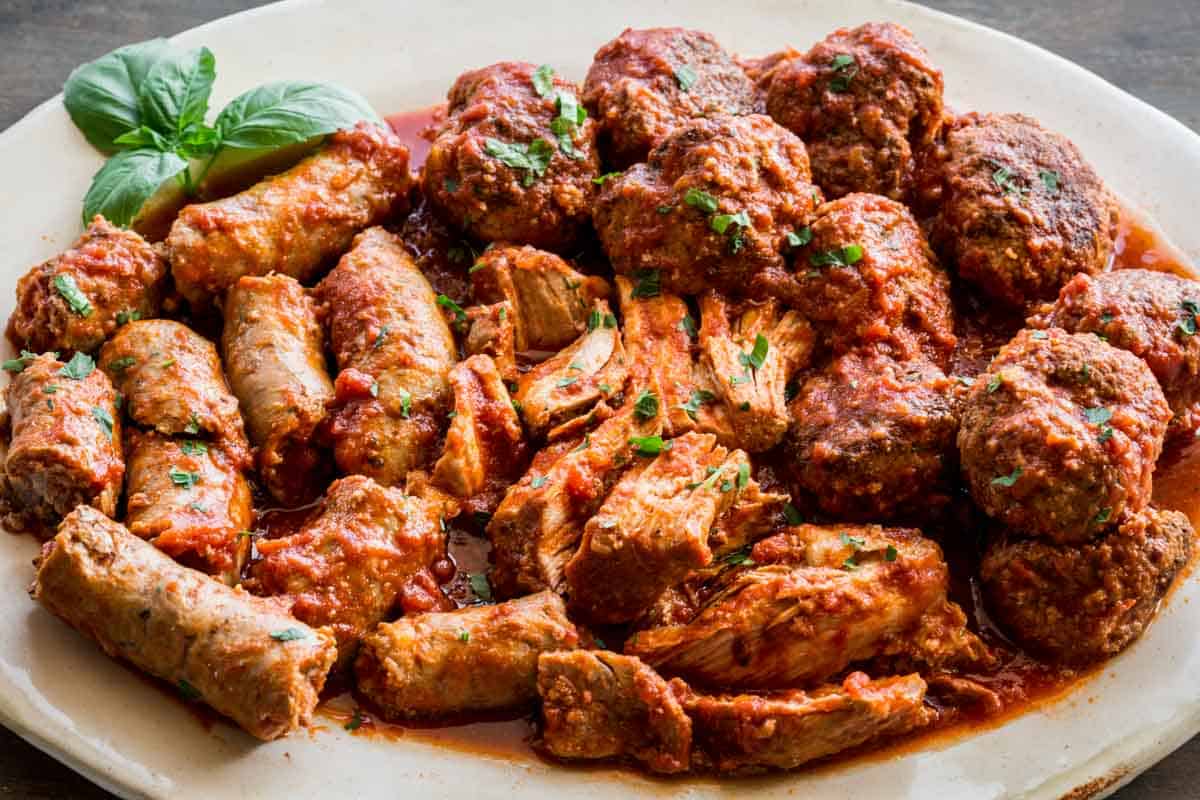
Helpful Equipment
- Large Pot or Dutch Oven: A large, heavy-bottomed pot or Dutch oven is essential for holding all of the sauce and also for retaining a nice low simmer as the sauce cooks over low heat.
- Large Stock Pot - For cooking the pasta.
- Wooden Spoon: A wooden spoon is traditional for stirring the sauce, but any type of large spoon will work.
- Immersion Blender or Food Mill (Optional): If you prefer using whole peeled tomatoes and want a super smooth sauce, use an immersion blender or food mill to puree the tomatoes before adding to the sauce.
- Can Opener: If you're using canned tomatoes, a can opener is necessary to open the cans.
- Large Strainer or Colander: For draining pasta.
- Large Slotted Spoon - For removing the meat from the sauce.
- Gravy Boat - For serving extra sauce at the table. A gravy boat is the easiest way to do it - and how my grandma always did.
Step by step instructions
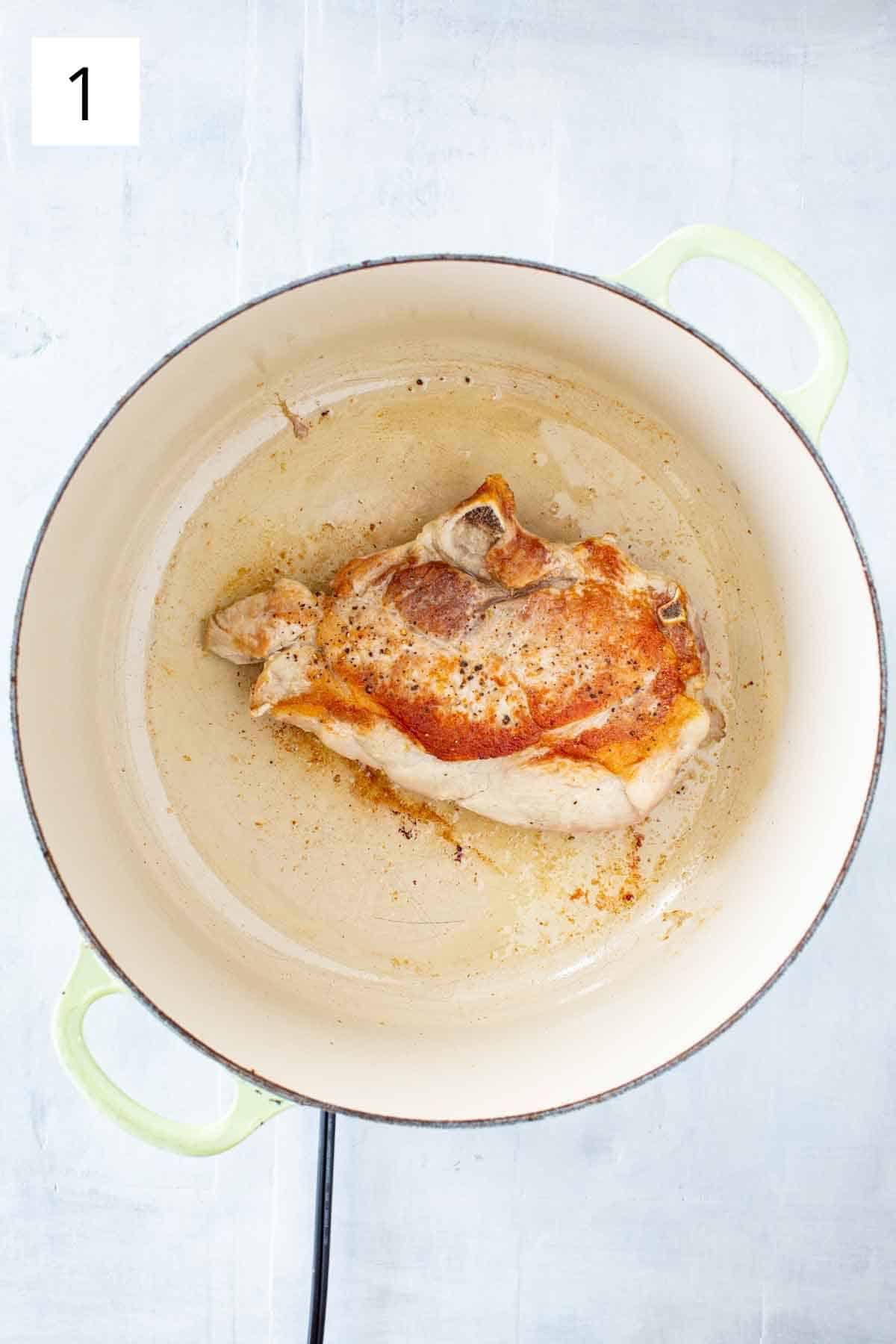
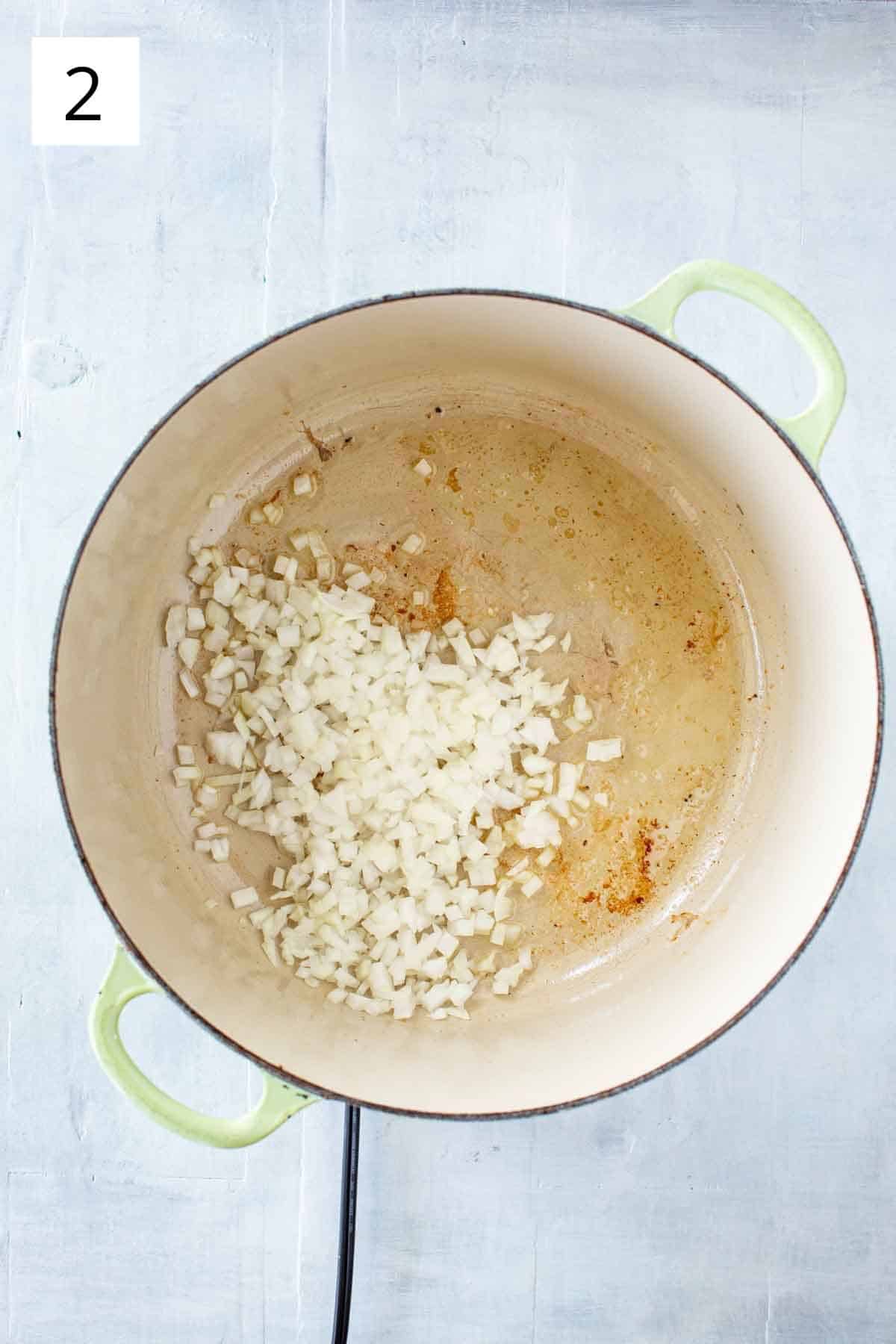
1) First, sear the pork to develop a nice depth of flavor.
Heat olive oil in a large pot or Dutch oven over high heat. Season the pork and cook on each side until nicely browned. Set aside.
2) Lower the heat, then sauté the onions until soft.

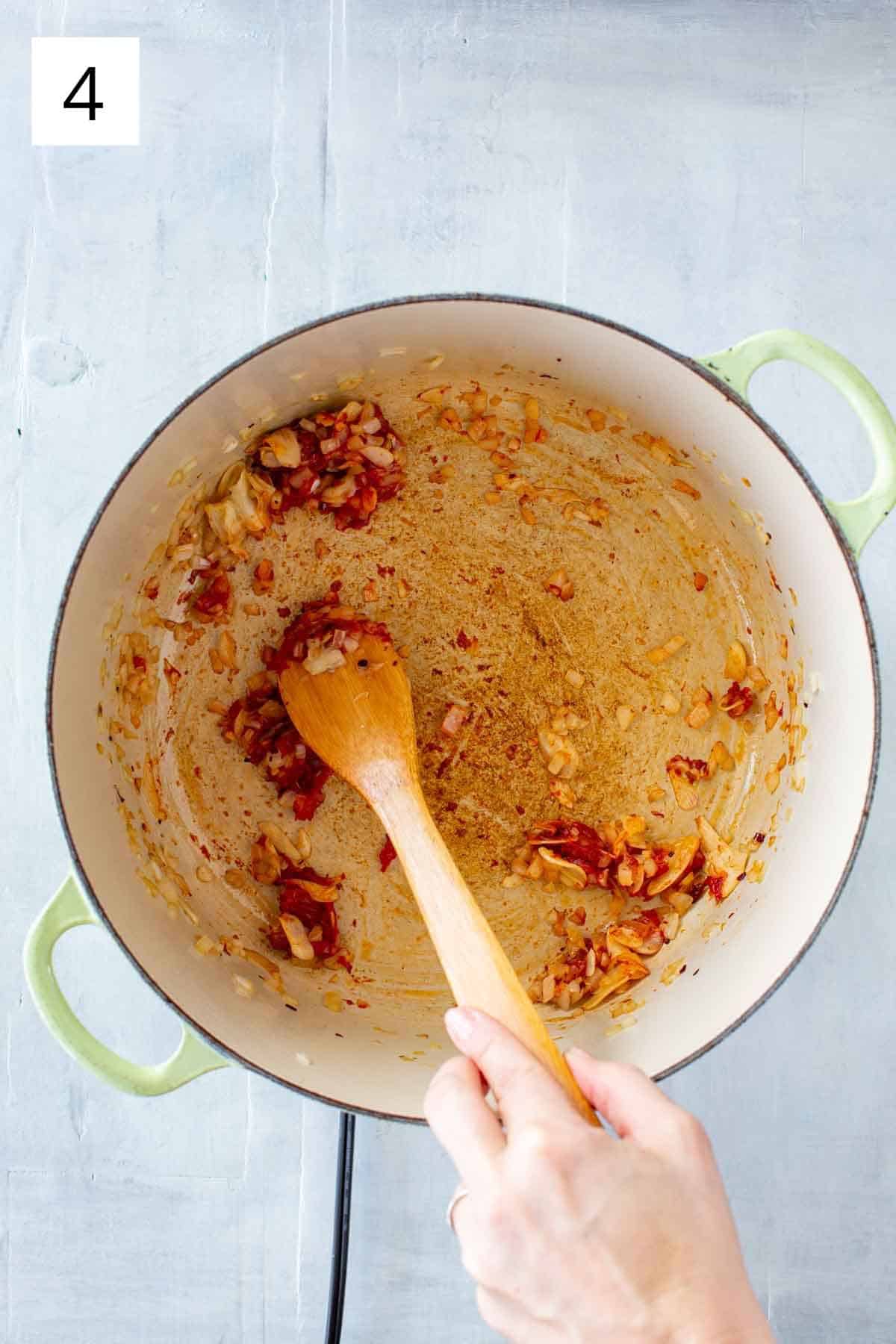
3) Add the garlic and chili flakes, then continue cooking for another 2 minutes.
Tip: Be careful not to brown the garlic and onions. Cook them nice and gently just to soften.
4) Stir in the tomato paste.
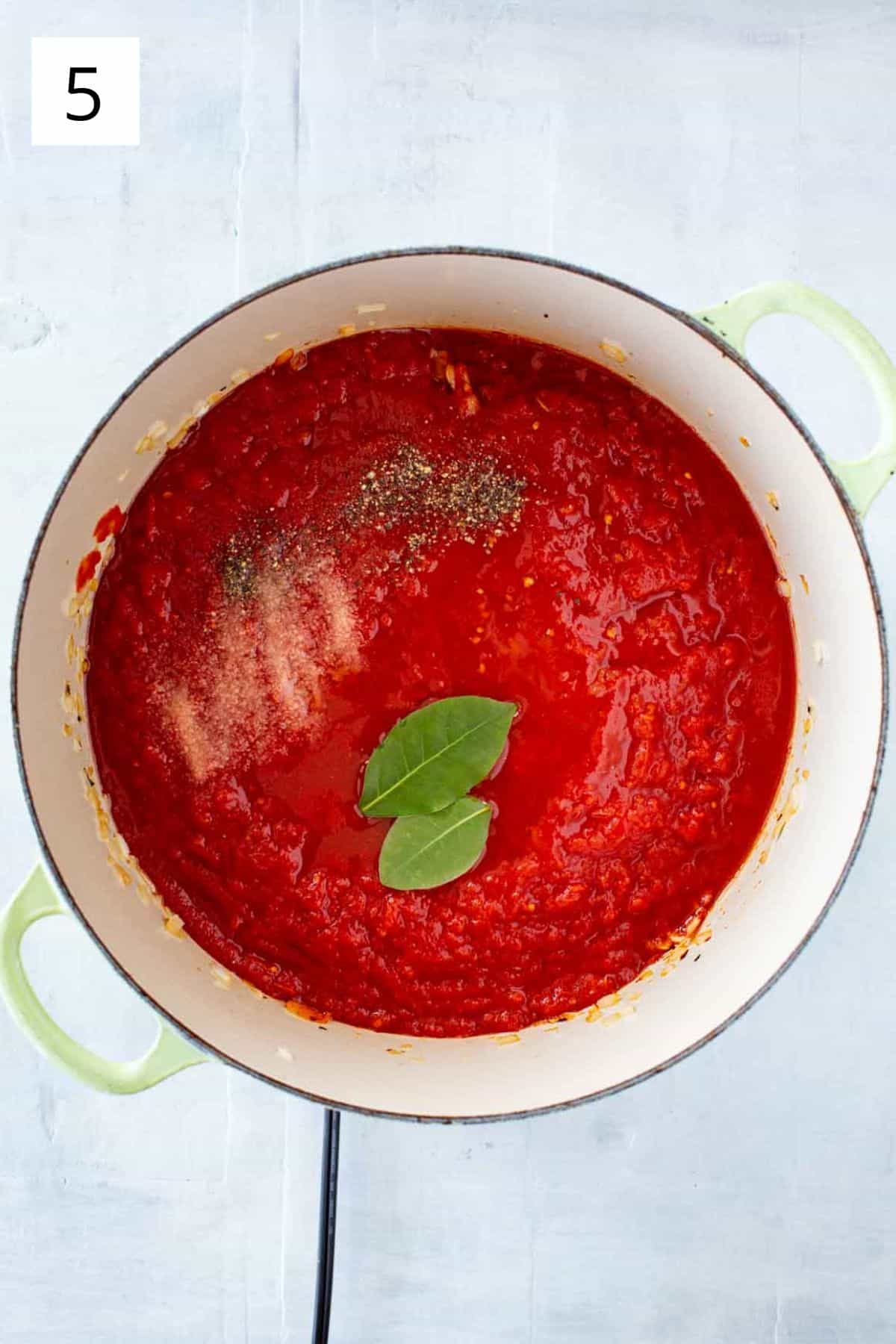
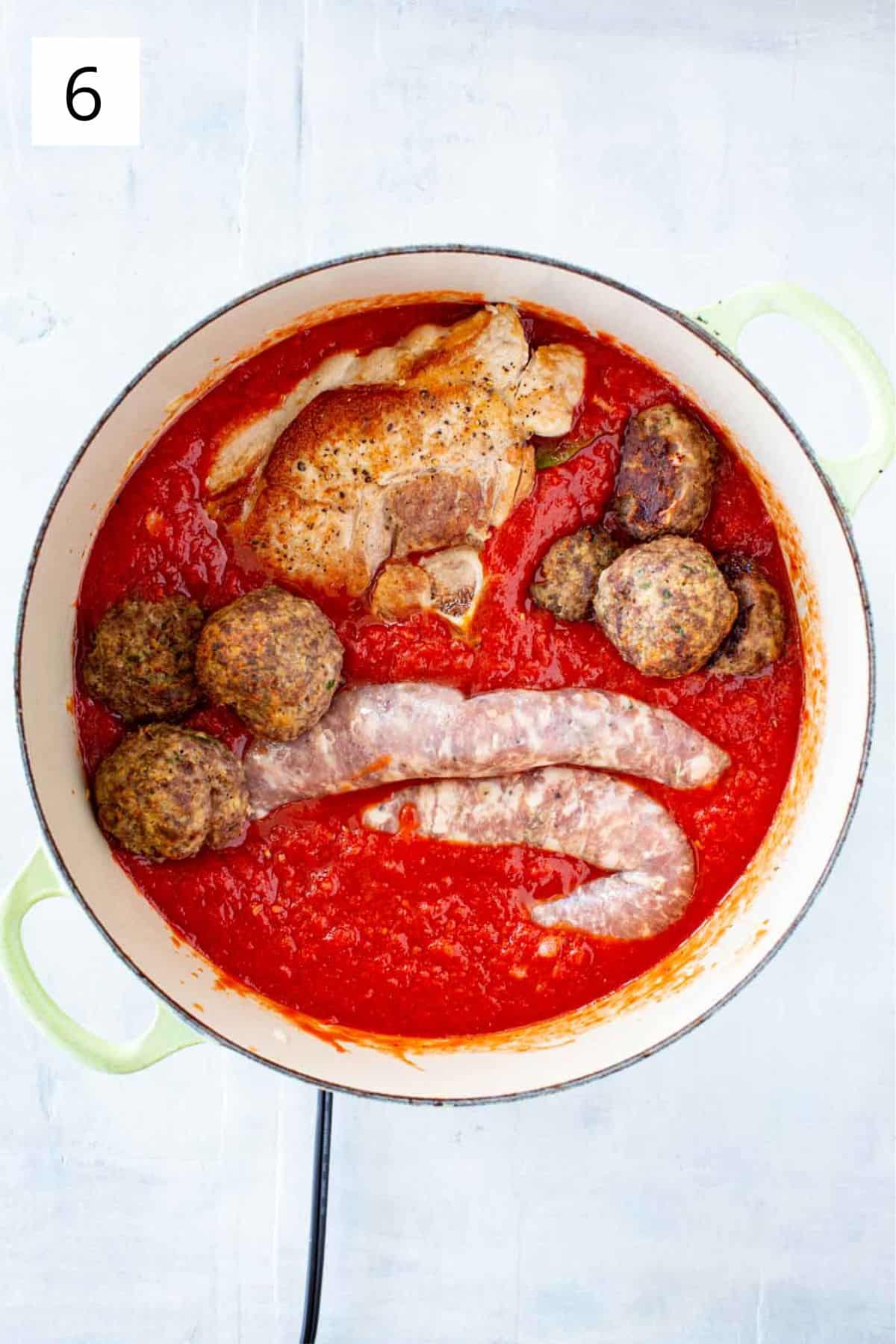
5) Add the tomatoes, bay leaves and parsley, then season with salt and pepper. Fill one empty tomato can with water and add it to the pot, then stir to combine.
Tip: If using whole peeled tomatoes, use the back of a wooden spoon to break them apart. For a smoother sauce, an immersion blender to puree the tomatoes before adding to the pot.
6) Bring the sauce up to a boil, then add the pork loin, sausage and meatballs, then reduce the heat to low. Simmer on the lowest possible heat setting for about 3 hours, or until the pork is falling apart and tender.
Tip: It's important to stir the pot about every 20 minutes or so to prevent the bottom from burning.
Turn off the heat and allow the meats to sit in the sauce until ready to eat. I like to make my sauce on Sunday morning, then let it hang out on the stove all day.
Taste the sauce and adjust the seasonings as needed. Remove the bay leaves and any bones from the pork, then use a slotted spoon to transfer the meats to a large platter, and serve with pasta. Enjoy!
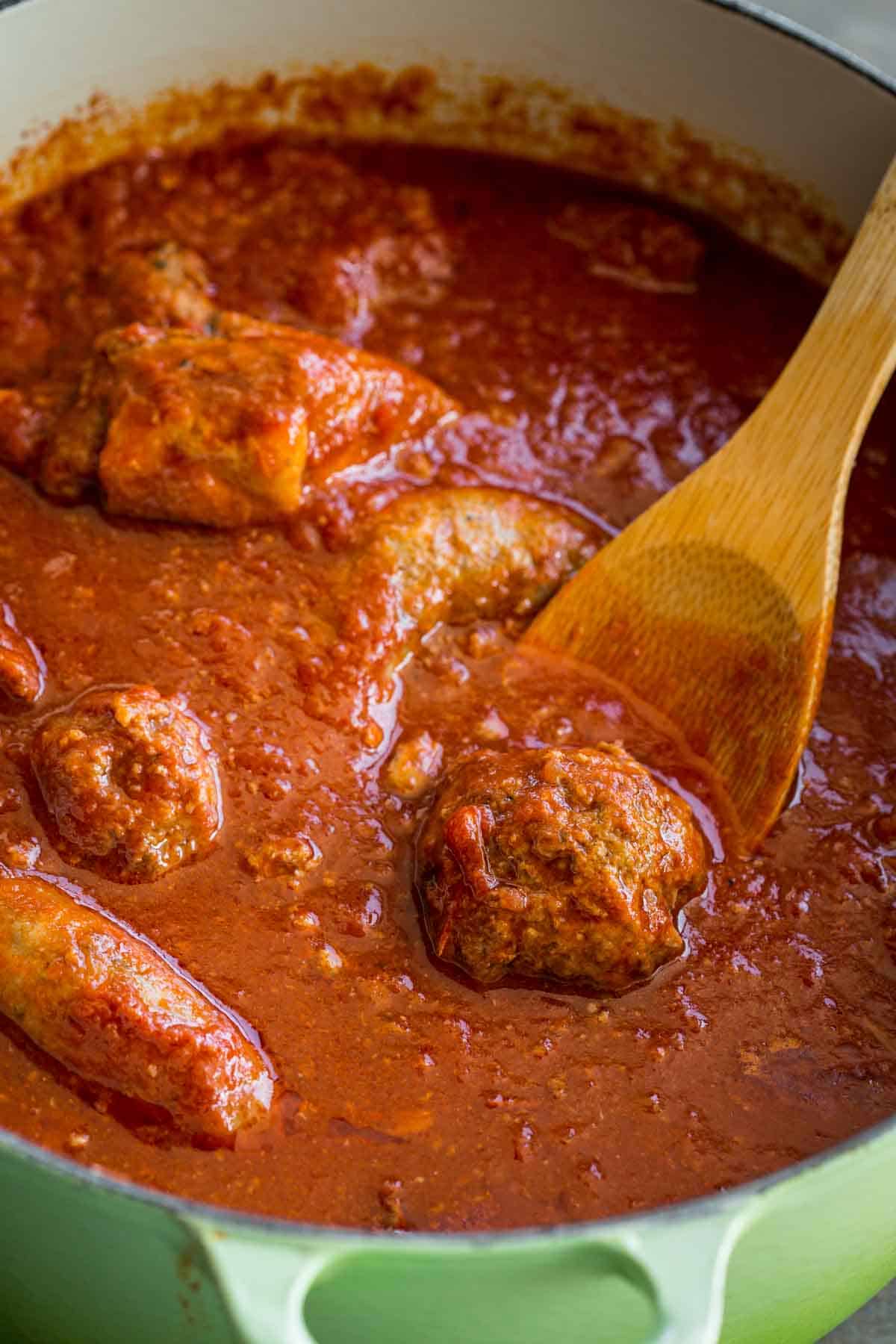
Tips for success
- Cook the onion and garlic slowly over medium-low heat to avoid browning.
- Have your can of tomatoes opened and ready before adding the garlic so that you can add it quickly to prevent the garlic from burning, which can happen quickly.
- For a smoother sauce, use an immersion blender to puree the chunks of tomato and onion, but be sure to remove the bay leaves first.
- Tomato paste is optional. My family like their sugo a little bit thinner, but it adds nice body to the sauce. If you like your gravy a little bit thicker, don't skip it! You can also thin out the sauce with more water as needed.
- Adding sugar to sauce is controversial amongst Italians, but a little pinch can help mellow the acid and balance the flavor. It won’t make the sauce sweet as long as you use a small amount!
- Make sure the sauce is simmering on the lowest heat possible, and give it a stir at least every 20 minutes to ensure the bottom doesn't burn.
- After sautéing the vegetables and adding the tomatoes, you can transfer the sauce to a slow cooker or crock pot, add the meat, and let it cook on low for 5-6 hours.
- This recipe is very forgiving - you can adjust the amount or type of meat to suit your preference and the number of people you're serving.
- Italian red gravy is very rich, so consider finishing with some fresh basil or parsley to add a little freshness.
- Be sure to make enough to have leftovers! They taste even better the next day and freeze beautifully for later.
Serving Suggestions
How to Serve
This is a family recipe, so I'm sharing how my Italian family likes to serve our pasta sugo recipe, aka Italian red gravy. This meat-filled Italian tomato sauce is meant to be served family style. Serve it in the center of a large table, or buffet style on a separate table.
- Pasta - Pasta is always served with Sunday gravy. My favorite pasta to use is rigatoni, but spaghetti, linguine, penne or your favorite pasta will work. Toss al dente pasta with a little bit of sauce and a splash of pasta water until every noodle is evenly coated. Serve the pasta with the meats and extra sauce on the side.
- Meats and Sauce - Use a slotted spoon to remove the meat from the sauce and place it on a large serving platter. Transfer the sauce to gravy boats or pitchers and serve along side the pasta and meat.
- Grated cheese - Always have a bowl of grated cheese for passing around the table. I use either grated Locatelli pecorino Romano, grated Grana Padano or grated Parmigiano Reggiano cheese for topping. Just be sure to use a good quality, freshly grated cheese and not the pre-grated cheese in a can.
- Ricotta cheese - It's traditional in our family to eat pasta sugo with a scoop of ricotta cheese on the side. There's always a bowl of ricotta on the table for passing, and it's my personal favorite addition to the meal. Especially when it's homemade ricotta cheese.
What to serve with it
This authentic Italian Sunday gravy recipe is a classic and comforting dish that your entire family will love. Make your dinner extra special by including some starters, sides and dessert!
- The best Sunday dinners always start with a little Antipasto. Serve a few Italian appetizers or snacks like olives, marinated vegetables or caponata. Italian meats and cheeses or an appetizer like beef carpaccio are great to nibble on while the sauce simmers.
- I like to offset the rich gravy with something fresh and green, like a simple Italian salad or Caesar salad, or garlicky sautéed vegetables, like spinach, escarole or broccoli rabe.
- A basket of warm, crusty Italian bread or garlic bread is essential for mopping up every last bit of sauce (and sometimes we even make this chicken cutlet recipe to go along side as well!).
- Wine at the dinner table is a family tradition. Pair your Italian Sunday red gravy with a nice Italian red wine, like Chianti or Sangiovese.
- To end the meal, a traditional Italian or Sicilian dessert like Ricotta Pie would be ideal. Cannoli, tiramisu or ricotta cheesecake would all be great.
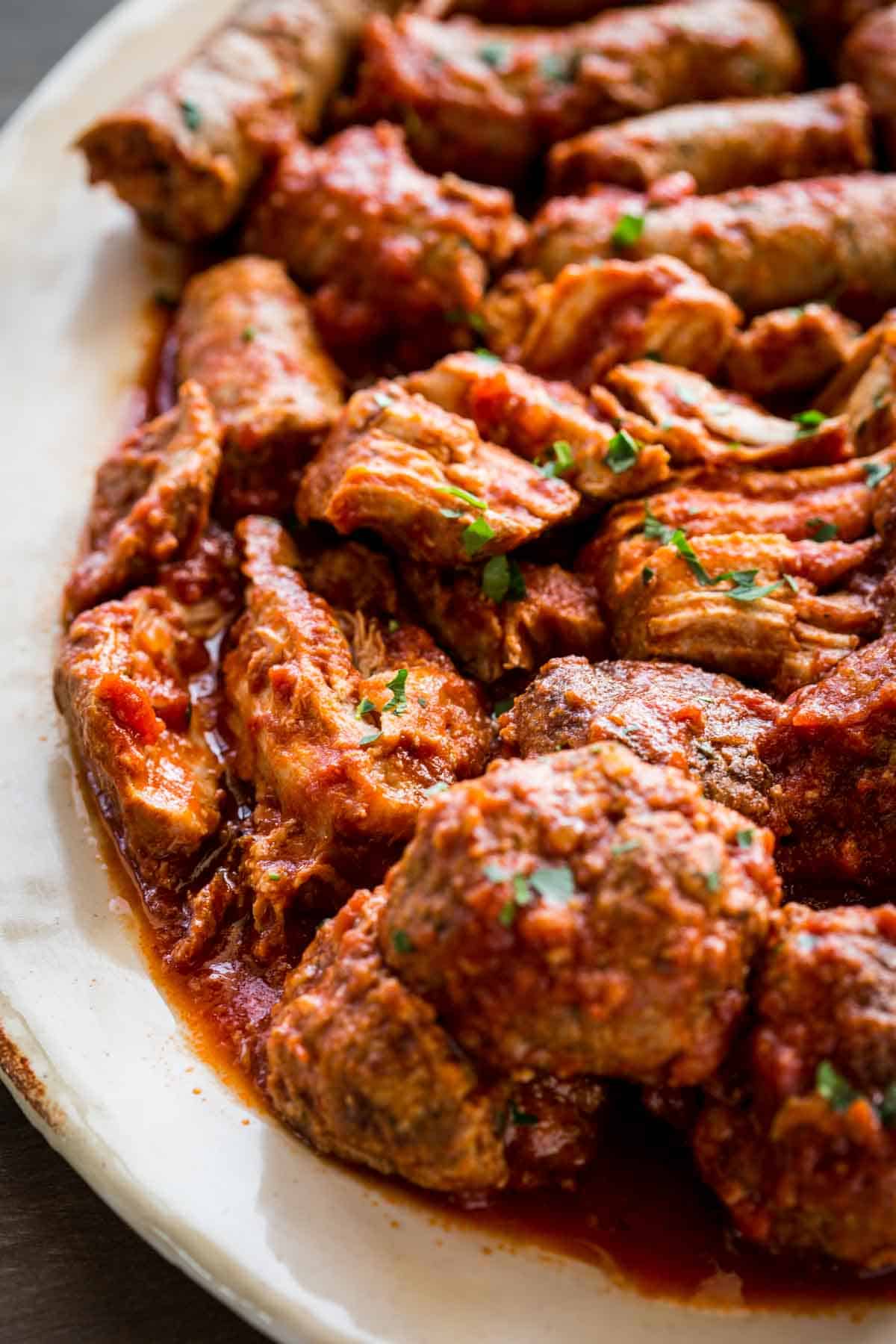
FAQ
The Italian word for sauce, "sugo," is sometimes translated to English as gravy, which is how some Italian immigrants began calling it gravy when they came to America. It is commonly debated whether this dish is called sauce or gravy in Italian American culture.
Typically marinara sauce, or tomato sauce, is prepared without meat and only simmers for 20-30 minutes. Red gravy, or sugo, contains big pieces of meat and takes several hours to cook so the meats become tender.
Italian red gravy, or sugo, is a southern Italian dish that consists of a rich red sauce with large pieces of meat. Typically meatballs, Italian sausage and tough cuts of either pork or beef tenderize and fall apart after cooking low and slow for several hours. The meats are typically served on the side along with pasta. Bolognese, or Ragu as it's called in Bologna, is a northern Italian specialty. It's made with ground meat, often pork, beef and/or veal, simmered with Italian sofrito (carrots, celery and onion), white wine, milk and very little tomato. It's traditionally tossed with tagliatelle pasta or layered in lasagne.
This recipe tastes even better the next day. Store leftover meat and sauce together in resealable containers and keep refrigerated for up to 5 days. Keep any leftover pasta separate. For longer storage, the containers can be frozen for up to 6 months. Defrost before reheating on the stove or in the microwave, stirring frequently.
Related Recipes
Did you LOVE this recipe? Please leave a star ⭐️ rating and comment to let other readers know! I absolutely love hearing from you and do my best to answer all questions and comments. I love seeing your creations so please tag me on Instagram @ColeyCooks!
Want to Save This Recipe?
Enter your email & I'll send it to your inbox.
By submitting this form, you consent to receive emails from Coley Cooks.
Italian Sunday Gravy (Sugo)
Ingredients
- 2 tablespoons extra virgin olive oil
- 2-3 lbs pork loin pork chops, ribs and/or neck bones
- kosher salt and black pepper to taste
- 1 small yellow or sweet onion finely diced
- 5 cloves garlic very thinly sliced
- pinch of red chili flakes
- 3 tablespoons tomato paste
- 2 28- ounce cans whole peeled tomatoes or crushed tomatoes
- 2 bay leaves
- 1 tablespoon finely minced Italian parsley
- pinch of sugar optional
- 1 ½ lbs Italian sausage hot, sweet or both
- 1 batch homemade Italian meatballs or 16-20 store-bought meatballs cooked
- pasta for serving
- grated Pecorino Romano cheese for serving
- Ricotta cheese for serving
Instructions
- Heat olive oil in a large pot or Dutch oven over high heat. Season the pork on all sides with salt and pepper, then sear until nicely browned on all sides. Remove and set aside.
- Lower the heat to medium, then add the onions to the pot and sauté until soft, about 5 minutes.
- Add the garlic and chili flakes, then continue cooking for another 2 minutes.
- Stir in the tomato paste for about 1-2 minutes.
- Add the tomatoes, bay leaves and parsley, then season with salt and pepper. Fill one empty tomato can with water and add it to the pot, then stir to combine. If using whole peeled tomatoes, use the back of a wooden spoon to break them apart, or use an immersion blender for a smoother sauce.
- Bring the sauce up to a boil, then add the pork loin, sausage and meatballs and reduce the heat to low. Simmer on the lowest possible heat setting, stirring about every 20 minutes to prevent the bottom from burning, for about 3 hours, or until the pork is falling apart. Turn off the heat and allow the meats to sit in the sauce until ready to eat.
- Taste the sauce and add more salt if needed. Remove the bay leaves and any bones from the pork, then use a slotted spoon to transfer the meats to a large platter.
- Toss al dente pasta with a little bit of sauce, then transfer the rest to gravy boats or another serving vessel, and serve the pasta with the platter of meats and sauce on the side, with a bowl of grated cheese and a bowl of ricotta for passing at the table.
Notes
- Cook the onion and garlic slowly over medium-low heat to avoid browning.
- Have your can of tomatoes opened and ready before adding the garlic so that you can add it quickly to prevent the garlic from burning, which can happen quickly.
- For a smoother sauce, use an immersion blender to puree the chunks of tomato and onion, but be sure to remove the bay leaves first.
- Tomato paste is optional. My family like their sugo a little bit thinner, but it adds nice body to the sauce. If you like your gravy a little bit thicker, don't skip it! You can also thin out the sauce with more water as needed.
- Adding sugar to sauce is controversial amongst Italians, but a little pinch can help mellow the acid and balance the flavor. It won’t make the sauce sweet as long as you use a small amount!
- Make sure the sauce is simmering on the lowest heat possible, and give it a stir at least every 20 minutes to ensure the bottom doesn't burn.
- After sautéing the vegetables and adding the tomatoes, you can transfer the sauce to a slow cooker or crock pot, add the meat, and let it cook on low for 5-6 hours.
- This recipe is very forgiving - you can adjust the amount or type of meat to suit your preference and the number of people you're serving.
- Italian red gravy is very rich, so consider finishing with some fresh basil or parsley to add a little freshness.
- Be sure to make enough to have leftovers! They taste even better the next day and freeze beautifully for later.

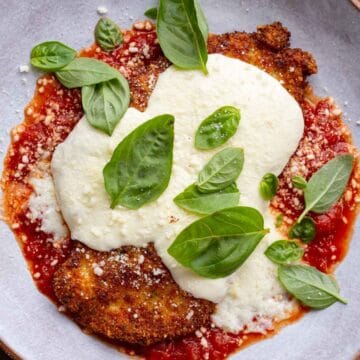




I stumbled on to this webpage and recipe by accident. Being from Sorrento with friends from Sicily, the consensus is sauce. LOL. Gravy is for the people named Smith from Kansas. Thumbs up for the parmesan rind trick. Hard boiled eggs? Never seen that or heard of it, so thumbs up also for teaching me something new. The use of ricotta was surprising as well.
Hey Dino from Sorrento! If I've learned anything from traveling in Italy and knowing hundreds of Italians and Italian Americans, it's that everyone does things a little bit differently. Recipes, methods and ingredients can vary widely between cities, regions, etc., and then gets adapted and changed through generations, based on budget, ingredient availability and taste. There is no right or wrong way. There is only your way! And this is mine. 🙂
Do you cover it when you simmer for 3 hours??
Yes. But I usually leave the lid cracked a little bit
Great recipe! I like to start with pancetta then the onions and garlic.
So glad you love the recipe! Pancetta would make this even more delicious!
My Nonni used to make Sugo and I can still remember the smell, This is very close! She used beef..normally short ribs, which I did as well. I added a little oregano, 2 cups of beef stock and a touch of dried garlic, and oh my,…,was it good! Not Nonni’s but Sooo Close! Thank you!
I'm so happy you loved the recipe! Short ribs are an amazing addition. Thanks for leaving a review - Nonni would be proud! <3
Very simple, yet complex flavors and absolutely delicious. Thank you for sharing ~dee
So glad you enjoyed the recipe!
An easy and authentic recipe. Very special.
Thank you for such a nice comment. I'm glad you appreciate the recipe! <3